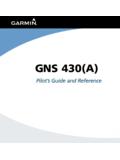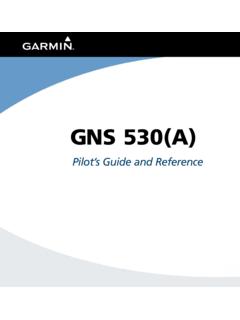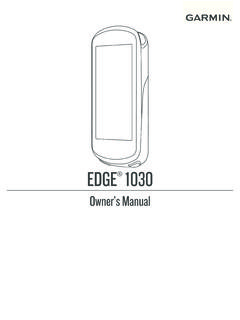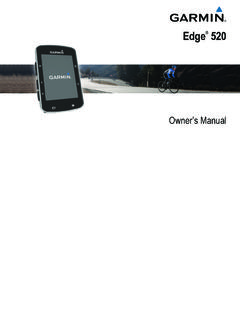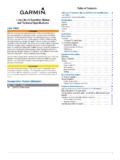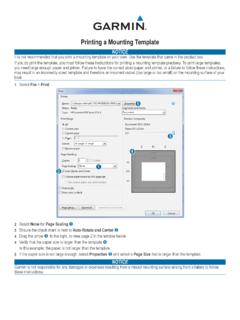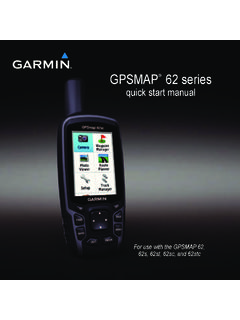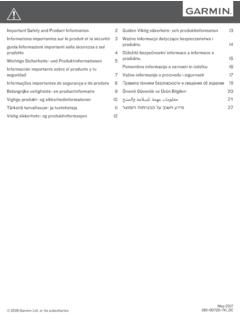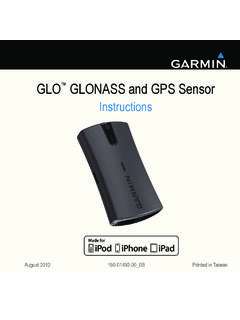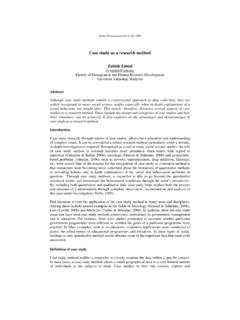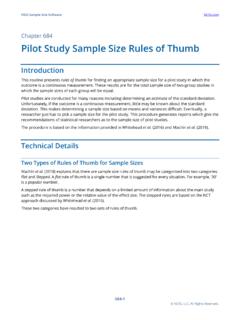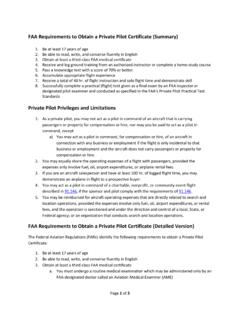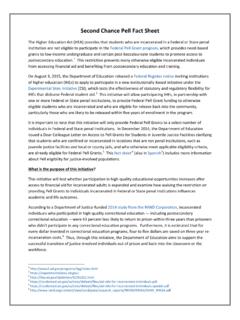Transcription of Pilot’s Training Guide
1 Garmin International, East 151st StreetOlathe, KS 66062, AT, Turner Road SESalem, OR 97302, (Europe) House, Bulls Copse RoadHoundsdown Business ParkSouthampton, SO40 9RB, :44 :44 CorporationNo. 68, Jangshu 2nd RoadShijr, Taipei County, Taiwanp:886 :886 s Training GuideIntegrated Flight DeckPilot s Training Guide190-00368-05 Revision B ii GIFD Pilot s Training Guide 190-00368-05 Rev. B Copyright 2006, 2008 Garmin Ltd. or its subsidiaries. All rights reserved. Garmin International, Inc., 1200 East 151st Street, Olathe, Kansas 66062, Tel: 913 Fax: 913 Garmin AT, Inc., 2345 Turner Road SE, Salem, OR 97302, Tel: 503 Fax: 503 Garmin (Europe) Ltd.
2 , Liberty House, Bulls Copse Road, Houndsdown Business Park, Southampton, SO40 9RB, Tel: 44 Fax: 44 Garmin Corporation, No. 68, Jangshu 2nd Road, Shijr, Taipei County, Taiwan Tel: 886 Fax: 886 Website Address: Except as expressly provided herein, no part of this manual may be reproduced, copied, transmitted, disseminated, downloaded or stored in any storage medium, for any purpose without the express written permission of Garmin. Garmin hereby grants permission to download a single copy of this manual and of any revision to this manual onto a hard drive or other electronic storage medium to be viewed for personal use, provided that such electronic or printed copy of this manual or revision must contain the complete text of this copyright notice and provided further that any unauthorized commercial distribution of this manual or any revision hereto is strictly prohibited.
3 Information in this document is subject to change without notice. Garmin reserves the right to change or improve its products and to make changes in the content of this material without obligation to notify any person or organization of such changes or improvements. Garmin is a registered trademark of Garmin Ltd. or its subsidiaries; this trademark may not be used without the express permission of Garmin. May 2008 Printed in 190-00368-05 Rev. B GIFD Pilot s Training Guide iii 1 Garmin Integrated Flight 1 1 Flight and Ground 1 Level of Knowledge 1 Ground Lesson 3 INTRODUCTION AND GARMIN INTEGRATED FLIGHT DECK SYSTEM 3 Exercise.
4 3 Terminology and Review of Pertinent Federal Aviation 3 Exercise : Component 6 Ground Lesson 9 TRANSITION TO THE PRIMARY FLIGHT DISPLAY (PFD).. 9 Exercise : Instrumentation 9 Exercise : Instrumentation 10 Ground Lesson 11 POWER-UP, SELF-TEST, 11 Exercise : System Ground Lesson 13 TRANSPONDER OPERATION .. 13 Exercise : Operating Modes and Code 13 Exercise : Practice (Optional).. 14 Ground Lesson 15 COM RADIO AND AUDIO PANEL 15 Exercise : COM Operation and Methods of Frequency 15 Exercise : Practice (Optional).. 16 Exercise : Audio Panel 17 Ground Lesson 19 19 Exercise : Land-based Navigational 19 Exercise : Practice (Optional).. 21 Exercise : GPS 22 Exercise : Practice (Optional).. 23 Exercise : Instrument 24 Exercise : Practice (Optional).. 26 Exercise : Vertical Navigation (VNAV).. 27 Exercise : 28 Ground Lesson 29 MULTI FUNCTION DISPLAY (MFD) OPERATION.
5 29 Exercise : MFD Configuration and 29 Ground Lesson 31 PRIMARY FLIGHT DISPLAY (PFD) OPERATION .. 31 Exercise : PFD Configuration and 31 Ground Lesson 33 EMERGENCY 33 Exercise : Emergencies and Failure 33 Ground Lesson 35 TERRAIN 35 Exercise : TAWS 35 iv GIFD Pilot s Training Guide 190-00368-05 Rev. B Ground Lesson 37 TRAFFIC 37 Exercise : Traffic Information 37 Ground Lesson 39 WEATHER 39 Exercise : Weather and Digital Audio 39 Exercise : Lightning 42 Exercise : Weather 43 Ground Lesson 45 GFC 700 AUTOMATIC FLIGHT CONTROL SYSTEM (AFCS).. 45 Exercise : Flight Director and Autopilot 45 47 CONSIDERATIONS ON USING THE GARMIN INTEGRATED FLIGHT DECK TO ENHANCE THE AERONAUTICAL DECISION MAKING (ADM) PROCESS AND SINGLE-PILOT RESOURCE MANAGEMENT (SRM).. 47 190-00368-05 Rev. B GIFD Pilot s Training Guide 1 INTRODUCTION GARMIN Integrated Flight Deck (GIFD) The GIFD is a completely integrated avionics system, designed to fit a broad range of aircraft models.
6 It is an all-glass fight deck that presents flight instrumentation, location, navigation, communication, and identification data on large-format, high-resolution displays. The digital data presentation on the GIFD puts all flight-critical information literally at the pilot s fingertips. Purpose This Pilot s Training Guide is provided to help the pilot transition to GIFD-equipped aircraft. Use this study Guide in combination with the Simulator and/or the Pilot s Guide as well as the flight instructor s guidance and feedback to maximize Training before taking delivery of a new GIFD-equipped aircraft. NOTE: Ground lessons should be completed before starting flight Training . NOTE: In this Training Guide , each lesson contains exercises as well as a list of resources that are recommended before completing these exercises. Flight and Ground Instruction It is important to coordinate ground lessons with a properly trained flight instructor.
7 Work with an instructor to make sure that the system is fully understood. This Training Guide works best if an instructor is involved from the very beginning. Work with an instructor to ensure that the flight lessons cover all appropriate material. Note that the instructor may determine that additional Training is required to review aircraft systems, procedures, airspace, or other knowledge areas. Practice under an instructor until confidently proficient with the system. Level of Knowledge Attained The material contained in this Guide is designed to help pilots progress from basic to advanced levels of knowledge. The basic skills of interpreting the Primary Flight Display (PFD), tuning the radios, and operating the Audio Panel are covered early on in the Training material. Later sections cover navigation, terrain, and other more complex material. The Pilot s Training Guide is designed so that pilot and instructor can begin basic Training quickly.
8 NOTE: It is not necessary to complete the Navigation portion of the material before taking off on a local Training flight. 2 GIFD Pilot s Training Guide 190-00368-05 Rev. B BLANK PAGE 190-00368-05 Rev. B GIFD Pilot s Training Guide 3 Ground Lesson 1 INTRODUCTION AND GIFD SYSTEM OVERVIEW Objectives Upon completion of this lesson, the pilot should be able to do the following: Describe the basic components of the Garmin Integrated Flight Deck Describe the communication between GIFD components Resources GIFD Pilot s Guide Aircraft Flight Manual (AFM) and supplements Pilot s Operating Handbook (POH) and supplements Aeronautical Information Manual (AIM) Federal Aviation Regulations (FAR) Exercise : Terminology and Review of Pertinent Federal Aviation Regulations 1.
9 Define and describe the following navigation abbreviations and acronyms: WAAS The Wide Area Augmentation System is a satellite navigation system consisting of equipment and software which augment the GPS Standard Positioning Service (SPS). It provides enhanced integrity, accuracy, availability, and continuity over and above GPS SPS. The differential correction function provides improved accuracy required for precision approach. LNAV Lateral Navigation provides lateral guidance to a profile or path. This terminology is used for GPS non-precision approaches. LNAV/VNAV Lateral Navigation/Vertical Navigation describes an approach in which lateral guidance as well as vertical glide slope guidance is provided. LPV Localizer Performance with Vertical guidance is a new type of APV approach procedure in which the angular lateral precision is combined with an electronic glidepath.
10 TERPS approach criteria are very similar to that used for ILS approaches. VNAV (or VNV) Vertical Navigation manages the altitude profile. The concept of the VNAV is to assign a target altitude to assist in controlled decent operations. Using the flight plan, a target altitude may be assigned to any waypoint. To reach the target altitude, the rate of descent is calculated and displayed and vertical guidance is provided to reach the descent profile. 4 GIFD Pilot s Training Guide 190-00368-05 Rev. B APV Approach with vertical guidance is an International Civil Aviation Organization (ICAO) term referring to specific ICAO criteria adopted in May 2000. This approach classification allows stabilized descent using vertical guidance without the accuracy required for traditional precision approach procedures. The US has developed criteria for lateral/vertical navigation (LNAV/VNAV) and LPV approach procedures that meet this approach classification.
